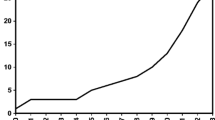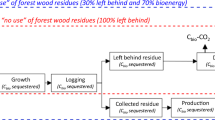Abstract
Purpose
This article aims to explore how different assumptions about system boundaries and setting of baselines for forest growth affect the outcome of climate impact assessments of forest products using life cycle assessment (LCA), regarding the potential for climate impact mitigation from replacing non-forest benchmarks. This article attempts to explore how several assumptions interact and influence results for different products with different service life lengths.
Methods
Four products made from forest biomass were analysed and compared to non-forest benchmarks using dynamic LCA with time horizons between 0 and 300 years. The studied products have different service lives: butanol automotive fuel (0 years), viscose textile fibres (2 years), a cross-laminated timber building structure (50 years) and methanol used to produce short-lived (0 years) and long-lived (20 years) products. Five calculation setups were tested featuring different assumptions about how to account for the carbon uptake during forest growth or regrowth. These assumptions relate to the timing of the uptake (before or after harvest), the spatial system boundaries (national, landscape or single stand) and the land-use baseline (zero baseline or natural regeneration).
Results and discussion
The implications of using different assumptions depend on the type of product. The choice of time horizon for dynamic LCA and the timing of forest carbon uptake are important for all products, especially long-lived ones where end-of-life biogenic emissions take place in the relatively distant future. The choice of time horizon is less influential when using landscape- or national-level system boundaries than when using stand-level system boundaries and has greater influence on the results for long-lived products. Short-lived products perform worse than their benchmarks with short time horizons whatever spatial system boundaries are chosen, while long-lived products outperform their benchmarks with all methods tested. The approach and data used to model the forest carbon uptake can significantly influence the outcome of the assessment for all products.
Conclusions
The choices of spatial system boundaries, temporal system boundaries and land-use baseline have a large influence on the results, and this influence decreases for longer time horizons. Short-lived products are more sensitive to the choice of time horizon than long-lived products. Recommendations are given for LCA practitioners: to be aware of the influence of method choice when carrying out studies, to use case-specific data (for the forest growth) and to communicate clearly how results can be used.






Similar content being viewed by others
Abbreviations
- CLT:
-
Cross-laminated timber
- CF:
-
Characterisation factor
- EU:
-
European Union
- GHG:
-
Greenhouse gas
- GWIrel :
-
Cumulative climate impact relative to the impact of 1 kg CO2 emission at year 0
- GWP:
-
Global warming potential
- iLUC:
-
Indirect land-use change
- IPCC:
-
Intergovernmental Panel for Climate Change
- LCA:
-
Life cycle assessment
- PEF:
-
Product environmental footprint
References
Berndes G, Ahlgren S, Börjesson P, Cowie A (2013) Bioenergy and land use change—state of the art. WIREs Energy Environ 2:282–303
Brander M (2015) Response to “Attributional life cycle assessment: is a land use baseline necessary?”. Int J Life Cycle Assess 20(12):1607–1611
Brander N (2016) Conceptualising attributional LCA is necessary for resolving methodological issues such as the appropriate form of land use baseline. Int J Life Cycle Assess 21:1816–1821
Cherubini F, Peters GP, Berntsen T, Strømman AH, Hertwich E (2011) CO2 emissions from biomass combustion for bioenergy: Atmospheric decay and contribution to global warming. GCB Bioenerg 3(5):413–426. https://doi.org/10.1111/j.1757-1707.2011.01102.x
Cherubini F, Bright RM, Strømman AH (2012) Site-specific global warming potentials of biogenic CO2 for bioenergy: contributions from carbon fluxes and albedo dynamics. Environ Res Lett 7(4). https://doi.org/10.1088/1748-9326/7/4/045902
Cherubini F, Guest G, Strømman AH (2013) Bioenergy from forestry and changes in atmospheric CO2: reconciling single stand and landscape level approaches. J Environ Manag 129:292–301
Cintas O, Berndes G, Cowie AL, Egnell G, Holmström H, Ågren G (2015) The climate effect of increased forest bioenergy use in Sweden: evaluation at different spatial and temporal scales. WIREs Energy Environ 5:351–369. https://doi.org/10.1002/wene.178
De Rosa M, Schmidt J, Brandão M, Pizzol M (2017) A flexible parametric model for a balanced account of forest carbon fluxes in LCA. Int J Life Cycle Assess 22(2):172–184
Eliasson P, Svensson M, Olsson M, Ågren G (2013) Forest carbon balances at the landscape scale investigated with the Q model and the CoupModel—responses to intensified harvests. Forest Ecol Manag 290:67–78
European Commission (2010) Communication from the Commission on the practical implementation of the EU biofuels and bioliquids sustainability scheme and on counting rules for biofuels, 2010/C 160/02. http://eur-lex.europa.eu/legal-content/EN/TXT/PDF/?uri=CELEX:52010XC0619(02)&from=EN. Accessed July 2015
European Commission (2013) Commission recommendation of 9 April 2013 on the use of common methods to measure and communicate the life cycle environmental performance of products and organisations. (2013/179/EU). http://eur-lex.europa.eu/legal-content/EN/ALL/?uri=OJ:L:2013:124:TOC. Accessed July 2015
Fouquet M, Levasseur A, Margnic M, Leberta A, Lasvaux S, Souyrib B, Buhéb C, Woloszynb M (2015) Methodological challenges and developments in LCA of low energy buildings: application to biogenic carbon and global warming assessment. Build Environ 90:51–59
Garcia R, Freire A (2014) Carbon footprint of particleboard: a comparison between ISO/TS 14067, GHG protocol, PAS 2050 and climate declaration. J Clean Prod 66:199–200
Guest G, Strømman AH (2014) Climate change impacts due to biogenic carbon: addressing the issue of attribution using two metrics with very different outcomes. J Sustain For 33(3):298–326
Guest G, Cherubini F, Strømman AH (2013) Global warming potential of carbon dioxide emissions from biomass stored in the anthroposphere and used for bioenergy at end of life. J Ind Ecol 17(1):20–30
Helin T, Sokka L, Soimakallio S, Pingoud K, Pajula T (2013) Approaches for inclusion of forest carbon cycle in life cycle assessment—a review. GCB Bioenergy 5(5):475–486
Helin T, Salminen H, Hynynen J, Soimakallio S, Huuskonen S, Pingoud K (2016) Global warming potentials of stemwood used for energy and materials in southern Finland: differentiation of impacts based on type of harvest and product lifetime. GCB Bioenergy 8(2):334–345
IPCC (2006) Guidelines for national greenhouse gas inventories. Prepared by the National Greenhouse Gas Inventories Programme. In: Eggleston HS, Buendia L, Miwa K, Ngara T, Tanabe K (eds) Volume 4—Agriculture, forestry and other land use, Chapter 4—forest land, Table 4.12. IGES, Japan
IPCC (2014) Climate change 2014: synthesis report. In: Core Writing Team, Pachauri RK, Meyer LA (eds) Contribution of working groups I, II and III to the fifth assessment report of the intergovernmental panel on climate change. IPCC, Geneva 151 p
Jørgensen SV, Hauschild MZ, Nielsen PH (2014) Assessment of urgent impacts of greenhouse gas emissions—the climate tipping potential (CTP). Int J Life Cycle Assess 19(4):919–930
Kilpeläinen A, Alam A, Strandman H, Kellomäki S (2011) Life cycle assessment tool for estimating net CO2 exchange of forest production. GCB Bioenergy 3:461–471
Köhl M, Lasco R, Cifuentes M, Jonsson O, Korhonen K, Mundhenk P, Navar J, Stinson G (2015) Changes in forest production, biomass and carbon: results from the 2015 UN FAO global forest resource assessment. For Ecol Manag 352:21–34
Koponen K, Soimakallio S, Kline K, Cowie A, Brandão M (2018) Quantifying the climate effects of bioenergy—choice of reference system. Renew Sust Energ Rev 81(2018):2271–2280. https://doi.org/10.1016/j.rser.2017.05.292
Lamers P, Junginger M (2013) The ‘debt’ is in the detail: a synthesis of recent temporal forest carbon analyses on woody biomass for energy. Biofuels Bioprod Biorefin 7:373–385
Levasseur A, Lesage P, Margni M, Deschenes L, Samson R (2010) Considering time in LCA: dynamic LCA and its application to global warming impact assessments. Environ Sci Technol 44:3169–3174
Levasseur A, Lesage P, Margni M, Samson R (2012) Biogenic carbon and temporary storage addressed with dynamic life cycle assessment. J Ind Ecol 17(1):117–128
Lundmark T, Bergh J, Hofer P, Lundström A, Nordin A, Poudel B, Sathre R, Taverna R, Werner F (2014) Potential roles of Swedish forestry in the context of climate change mitigation. Forests 5:557–578
Matthews R et al (2014) Review of literature on biogenic carbon and life cycle assessment of forest bioenergy. Final Task 1 report, DG ENER project, ‘Carbon impacts of biomass consumed in the EU’. https://ec.europa.eu/energy/sites/ener/files/2014_biomass_forest_research_report_.pdf. Accessed May 2015
Methanol Institute (2011) How is methanol made? http://www.methanol.org/methanol-basics/overview/how-is-methanol-made-.aspx. Accessed August 2015
Oerlikon Textile (2010) The fiber year 2009/10. A world survey on textile and nonwovens industry. http://www.indotextiles.com/download/Fiber%20Year%202009_10.pdf. Accessed August 2015
Røyne F, Peñaloza D, Sandin G, Berlin J, Svanström M (2016) Climate impact assessment in life cycle assessments of forest products: implications of method choice for results and decision-making. J Clean Prod 116:90–99
Sandin G, Peters GM, Svanström M (2013) Moving down the cause-effect chain of water and land use impacts: an LCA case study of textile fibres. Resour Conserv Recyl 73:104–113
Sandin G, Røyne F, Peñaloza D, Staffas L, Svanström M (2015) The method’s influence on climate impact assessment of biofuels and other uses of forest biomass. f3 report 2015:10, f3 The Swedish Knowledge Centre for Renewable Transportation Fuels, Sweden. Available at www.f3centre.se. Accessed January 2015
Searchinger T, Heimlich R, Houghton RA, Dong F, Elobeid A, Fabiosa J, Tokgoz S, Hayes D, Tun-Hsiang Y (2008) Use of U.S. croplands for biofuels increases greenhouse gases through emissions from land use change. Science 319(5867):1238–1240
Shen L, Worrell E, Patel MK (2010) Environmental impact assessment of man-made cellulose fibres. Resour Conserv Recyl 55:260–274
Sjølie HK, Solberg B (2011) Greenhouse gas emission impacts of use of Norwegian wood pellets: a sensitivity analysis. Environ Sci Pol 14(8):1028–1040
Skogsstyrelsen (2015) Forest and forestry in Sweden. Figure: “Annual cut and annual forest increment” (page 5). Available at: https://www.skogsstyrelsen.se/globalassets/in-english/forests-and-forestry-in-sweden_2015.pdf, Stockholm, Sweden
Soimakallio S, Cowie A, Brandão M, Finnveden G, Ekvall T, Erlandsson M, Koponen K, Karlsson PE (2015) Attributional life cycle assessment: is a land use baseline necessary? Int J Life Cycle Assess 20(10):1364–1375. https://doi.org/10.1007/s11367-015-0947-y
Soimakallio S, Brandão M, Ekvall Cowie A, Finnveden G, Erlandsson M, Koponen K, Karlsson PE (2016) On the validity of natural regeneration in determination of land use baseline [Letter to the editors]. Int J Life Cycle Assess 20(10):1–3
Spracklen DV, Bonn B, Carslaw KS (2008) Boreal forests, aerosols and the impacts on clouds and climate. Philos Trans A Math Phys Eng Sci 366(1885):4613–4626
Storaunet KO, Rolstad J (2002) Time since death and fall of Norway spruce logs in old-growth and selectively cut boreal forest. Can J For Res 32(10):1801–1812
Vogtländer J, van der Velden N, van der Lugt P (2014) Carbon sequestration in LCA, a proposal for a new approach based on the global carbon cycle; cases on wood and on bamboo. Int J Life Cycle Assess 19(1):13–23
Zanchi G, Pena N, Bird N (2012) Is woody bioenergy carbon neutral?—a comparative assessment of emissions from consumption of woody bioenergy and fossil fuel. GCB Bioenergy 4(6):761–772
Acknowledgements
This publication is the result of a project carried out within the collaborative research program Renewable transportation fuels and systems (Förnybara drivmedel och system) [Project no. 39588-1]. The authors would also like to thank the anonymous reviewers for their valuable input.
Funding
The project has been financed by the Swedish Energy Agency and f3 – Swedish Knowledge Centre for Renewable Transportation Fuels (see www.f3centre.se/samverkansprogram). Additional work by the corresponding author has been carried out with financial support from Formas (project EnWoBio 2014-172).
Author information
Authors and Affiliations
Corresponding author
Ethics declarations
Conflict of interest
The authors declare that they have no conflict of interest.
Additional information
Responsible editor: Jörg Schweinle
Electronic supplementary material
Online resource 1
Electronic Supplementary Material for the article, including the life cycle inventory data for each of the forest product case studies and their benchmarks, and also including dynamic LCA results with an alternative indicator: Cumulative impact – GWIcum (W*m2) (DOCX 673 kb)
Rights and permissions
About this article
Cite this article
Peñaloza, D., Røyne, F., Sandin, G. et al. The influence of system boundaries and baseline in climate impact assessment of forest products. Int J Life Cycle Assess 24, 160–176 (2019). https://doi.org/10.1007/s11367-018-1495-z
Received:
Accepted:
Published:
Issue Date:
DOI: https://doi.org/10.1007/s11367-018-1495-z




